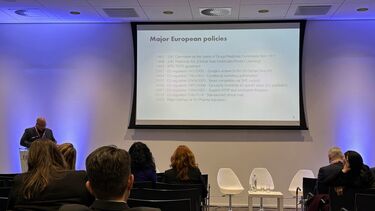Leaving any field in ethnography can be a tricky task. As Bourdieu notes on the ethnographersâ awkward gaze (Gidley, 2009), you cannot help but take something with you or to leave at least something behind â and you become other to both worlds as a result. As our project progresses from fieldwork (immersion at conferences) to analyses and write-up, reflecting back on the last four years, I have gained a far greater appreciation of the pharmaceutical industryâs inner workings â even publishing a health economics article as a result (Hanchard, 2025). I leave with a position closer to third-way politics than the critical âbig pharma badâ I had envisaged upon entry. My new manta: "...but it's more complicated than that". I leave behind a better understanding of what medical sociology can offer industry and policy debates in the hope widening industry thought to be more than periphery footnote or recommendations filler on âsocial factorsâ.
Following Terrapin eventsâ World Orphan Drug and World Evidence Pricing and Access (EPA) Congresses over the last four years began somewhat uneasily. Initially, I was held as outsider and met with scepticism. Two years later, I was invited to speak there. As the fieldwork draws to a close in 2025, the organiser took the time to ask engaging questions about the research progress, understanding the project aims surprisingly well. Throughout the fieldwork, both congresses have changed tack. The World EPA Congress in 2022 saw room sizes in the Dutch modernist central Amsterdam Beurs Van Berlage building become a little too small. Just three years later, it has once again outgrown its space â currently encompassing two giant halls of the glassy-brutalist Amsterdam RAI corporate venue complex in Zuidas (South Amsterdam). The event in 2025 gathered over 1,500 attendees and 300 speakers, with even more likely in 2026!
Congress topics have shifted over time too. In 2022, post-Covid caution saw a focus on market stability. By the World EPA Congress in 2023 focus had turned to access (in)equity for patients, and the expansion of increasingly niche markets (Hanchard, 2023). It moving on again to sustainability and regulatory change for the World EPA Congress in 2024. The latter, a response in part to an EU-level major overhaul of pharmaceutical policies in 2023. This year, AI took centre-stage. Various businesses offered the latest and greatest in AI, with platforms and tools of all kinds on show, and with surprising niches too. One stall offered virtual reality (VR) headsets to demo their product, an AI analytics informed training tool design to help market access organisations â[e]ngage in scenarios that mimic real-life interactions with healthcare professionals or payers, navigate complex compliance guidelines, and master the art of relationship building and sales strategies within a controlled, engaging virtual environmentâ (MArS, 2025). Others offered chocolates, coffee, notebooks, and Lego - while many had live demos of AI based products â all licensable for a reasonable fee. At the World EPA Congress in 2021, AI was something to be planned for, an emerging technology on the horizon, something due to arrive sometime soon. By the World EPA Congress in 2025 it has become quite clear that AI has landed firmly in the here and now, with an exciting ecosystem of products emerging. The same sentiment has been noted online by others too â see BÞnauâs (2025) post on LinkedIn for example. Throughout, rather than AI and data becoming platonic buzzwords, event talks fleshed out the contours of our new landscape in detail. That said my account only covers the first day of the congress â with an early morning Eurostar to IRDIRCâs (Re)Act in Brussels seeing me miss talk from the second and third days.
In terms of talk content, the congress chair Annette Powers (SVP of Global Market Access, Bristol Myers Squibbs) opened with discussion of sustainable access and trends in health economics and outcomes research (HEOR). Four keynotes then set the congress tone: Christoph Glaetzer (Janssen) talked about greater inclusion of patients in market access strategy decisions; Barry Farrimond (ZS) enticingly talked about âTransforming market access through Digital, AI, Technology & Analytics'; Chris Mancill (AstraZeneca) examined alliances in âIndustry commitments and collaborations to health system goalsâ, turning to data too in a discussion of the âtrends and opportunities in achieving health equity from the Access to Medicine Indexâ; Meanwhile, Jayasree Iyer (CEO, Access to Medicines Foundation) provided a focus on global healthcare access inequity.
Whilst at the event, I flitted between the ârare diseaseâ and âreimbursementâ tracks (speaking in the latter). I saw AI being used within clinical trial design, and Girisha Fernando (CEO of Lyfegen) offered a live demo of their âdrug contracting companionâ pricing simulator. Taking multiple sclerosis as a case example disease and North Carolina as an example US state, Fernando showed how the tool could quickly suggest an outcomes-based model as the most likely to be successful. In part, Fernando explained, that was due to that particular federal statesâ high number of people covered by Blue cross/Blue shield. As a large language model (LLM) based AI platform, Fernando noted that Lyfegenâs tool ingests real-world data (RWD) from clinical, epidemiological, and financial records alongside public internet records. With a few text-based entries and minor playing around with filters, the tool brought about suggestions in seconds, powered by Open AI GPT 4.0 and Googe Gemini Flash 2.0. Done manually, the same task may have taken a researcher or consultant a few days or even weeks. Meanwhile, others within the Q&A session noted that Anthropic's Claude 2.0 â an LLM often used within health technology Assessment (HTA) might have been another suitable alternative. The question then, was not whether AI was viable â but on which AI is best for each task. And Lyfegen's pricing simulator was far from the only working demo of product at the event.
Beyond AI, talk of reimbursement was equally as lively. In comparing countries, for example, Tomer Ben Zaken (Director at Astellas) noted that Israel has 100% universal coverage via four healthcare maintenance organisations (Clalit, Maccabi, Leumit, and Meuhedet). Each of which are non-governmental organisations that competitively bid on tenders, creating competition within closed bounds. As a pyramid structure of sorts, Zaken showed $116bn US dollars being allocated as a national budget for healthcare in 2019, with 40% of all national healthcare spends being out-of-pocket (payed by patients or private insurance), giving rise to monopoly markets - with only four state-sanction providers to choose from. Although, in a structure entirely differ to the EU, UK or USA - treatment price per indication is not permitted in Israel, instead medicines are charged by disease (as a whole) causing various challenges. Using the case of multiple myelopathies, Zaken showed that in 2020 a viable new treatment was rejected (no budget assigned). In 2021 it was rejected again with a focus on first line treatments only. In 2022, it was rejected yet again with a focus on second line treatment instead. Then, in 2023 it was approved, meaning where patients had been accessing the drug as third-line treatment (if two other cheaper and established options had failed), it was now as a first-line treatment despite its far higher cost placing strain on budgets. Access to the ârecommendedâ first-line treatment, then left at mercy of industry and regulators working with the four providers to set a price that would be manageable. Other talks were equally as insightful, and deep too. In my own talk, I restated the three narratives of orphan drug pricing (Hanchard, 2025) and drew on recent interviews to highlight the connection between policy, regulatory gaps, and issues in gaining access to treatment for US patients. As an example, I noted Charlotte's statement:
âSo a hospital might have a clinical trial, and actually the biotech companies are required to pay for the procedures of the clinical trialâĶ [but] if the child gets sick for some other reason, well, they're [already] at the hospital [but] it has to be covered by their insuranceâĶ.[So] there was a child who was eligible for a clinical trial, but came from a family that only had MedicaidâĶ they did not have private health insurance, [so] the hospital refused to allow them to participate in a clinical trial, becauseâĶ [their] Medicaid insurance was not as expansive as a private insurance, and which is essentially discrimination against poor people.â
Charlotte, USA
Connecting her statement to policy, and to the US Patient Protection and Affordable Care Act (ACA) 2010 in particular, I demonstrated how access and the actual prices paid by rare disease patients are directly impacted by regulatory changes, with variable inequities brought about as a result - such as some socio-economic groups being excluded from clinical trials on a coverage basis, the drugs developed being less representative of their target end-users than they perhaps ought to be.
Overall, the congress was positive in tone and celebratory of advances. AI's landing is clearly a boon for many aspects of healthcare, but only if used in the right way. There is a sense that the technology is here, but regulation is yet to catch up. In pricing, there was firm sense too that transferable exclusivity extension vouchers (usually used for to incentivise innovation and investment in antimicrobials) as a purportedly âzero-costâ (offset cost) way to incentivise innovation for the small markets posed by rare disease. No doubt these debates will have continued, but with overlapping conferences to attend, I left in the morning before the congress second day started, catching an early morning Eurostar to Brussels for the (Re)Act conferenceâĶ
References
BÞnau, P. (2025). âGenerative AI at the Gate: Impressions from the World EPA Congress 2025â, LinkedIn [Online]. .
Gidley, B. (2009). âA Note on the Awkwardness of the Ethnographerâ. The Sociological Review, 57(3), pp. 526-529. doi: .
Hanchard, M. (2023) âThe World EPA Congress and shift towards access equity and niche marketsâ, iHuman. [Blog}. /ihuman/blog/world-epa-congress-and-shift-towards-access-equity-and-niche-markets.
Hanchard, M. (2025) âDebates over orphan drug pricing: a meta-narrative literature reviewâ. Orphanet: Journal of Rare Disease. 20(107). doi: .
MArS (2025) Max Insights: The AI-Based Global Market Access Planning Tool [Online].




